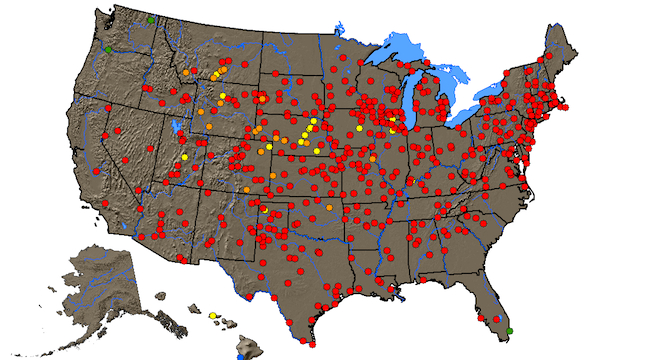It’s official: 2012 was the warmest year on record for the contiguous United States and the second most extreme in terms of weather events, according to the National Oceanic and Atmospheric Administration’s (NOAA) annual “State of the Climate” report released Tuesday.
The average temperature for the entire year was 55.3 degrees Fahrenheit, a full degree warmer than the previous record warmest year, 1998, and 3.2 degrees above the entire 20th century average.
While one degree may not sound like very much in terms of temperature as humans experience on a day-to-day basis, it is actually an enormous increase in the country’s climate history, as NOAA scientists explained in a press conference on their results Tuesday afternoon.
“The difference between the record coldest year and previous record warmest year was four degrees,” said Jake Crouch, a climate scientist at NOAA’s National Climatic Data Center, during the press conference. “So there’s 117 years of data that were encompassed by four degrees of an average temperature, and now the 2012 value is one degree outside of that envelope. So we’re taking quite a large step above what the period of record has shown for the contiguous U.S.”
Here’s a NOAA chart highlighting the most important numbers from the 2012 State of the Climate report (full supplemental material here):

While the 2012 annual weather and climate records were due to a “combination of climate change and natural variability,” per the NOAA, Crouch emphasized that “climate change has had a role” although it was “hard for us to say which part was dependent on climate change and which part dependent on local variability.”
“It’s hard to connect single events to trends that occur over decades,” said Deke Arndt, chief of NOAA’s climate monitoring branch at its National Climatic Data Center, during the press conference. “With that said, the heat that we saw [in 2012] of course fits into pattern of longterm events.”
Over the course of summer 2012, the second hottest summer on record, some 357 warm temperature records were broken and nearly one third of the national population, some 99.1 million people, endured at least 10 days with temperatures over 100 degrees Fahrenheit, NOAA reported.
19 states experienced warmest-ever records, NOAA noted, illustrating them on the following chart:

When it comes to extreme weather events, which includes everything from severe temperatures to droughts, tropical cyclones and wildfires, and which NOAA calculates as a single number, 2012 placed only behind 1998.
The climate extreme value for 2012 was 39, while 1998 earned a value of 43, due primarily due tropical cyclones that made landfall that year. The extremes value for 2012 was still two times the national average, as NOAA explained.
Here’s an NOAA chart of extreme weather records (temperature, dryness, wetness) broken across the country in 2012:

NOAA records the data for its annual report and monthly reports preceding it from monitoring stations managed by the National Weather Service.
Crouch also noted that 2012’s extreme weather score did not include Hurricane/Superstorm Sandy, which was no longer tropical when it made landfall on the East Coast in October. Scientists could not say whether the inclusion of Sandy in the data would have pushed 2012 above 1998 for the record setter in extreme weather events.
As NOAA noted in its report: “No major hurricanes struck the U.S. coast, marking the seventh consecutive year without a major hurricane strike.”
Here’s an NOAA video illustration of the 2012 Atlantic Hurricane season in 4.5 minutes:
What NOAA scientists could say with certainty on Tuesday is that 61 percent of the U.S. is still locked in drought as of the date the report was released.
The effects of that drought, while not quite as noticeable as they were summer 2012 and during the agriculture growing season, are still being felt, especially in the Mississippi river, which, reaching record lows, is causing problems for commercial shipping, and in the Great Lakes, which are also nearing record lows.
The drought is “not over,” Crouch said, “and I foresee it is going to be a big story moving forward in 2013.”
Beyond that, the future for the contiguous United States is clearly a warmer one and filled with more extreme weather events.
“The heat that we saw in the U.S. [in 2012]…was a huge exclamation point on the end of several decades of fairly consistent warming,” Arndt said, “and that’s consistent with what we would expect in a warming world.”






